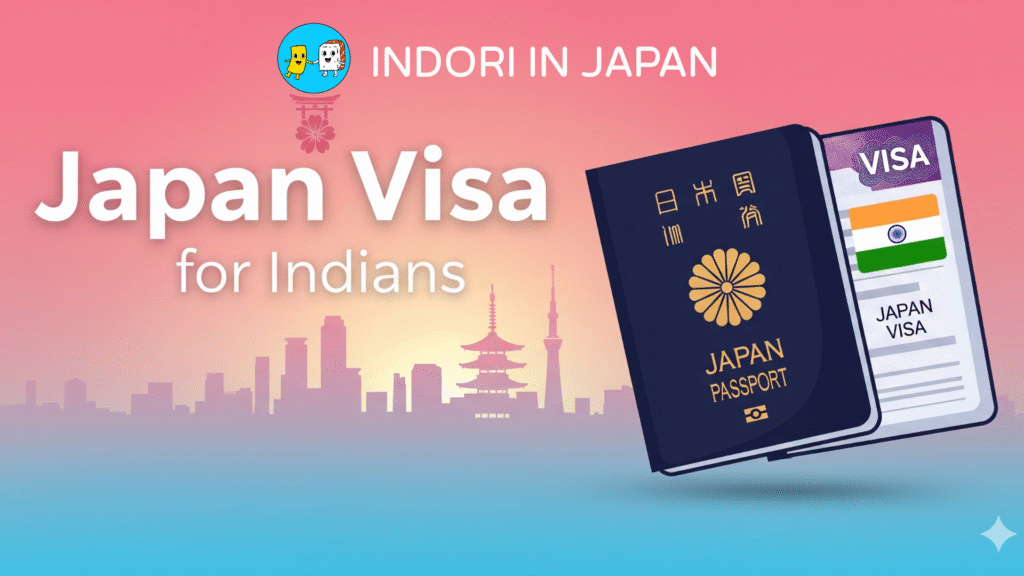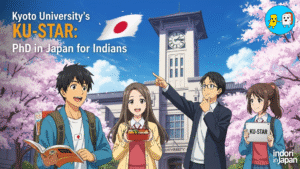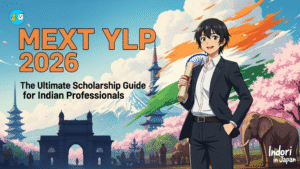Japan Visa for Indians: A Gaijin's Handbook to Your Dream Journey
皆さん、こんにちは!(Hello everyone!)
For those dreaming of a trip or a new life in Japan, the visa application process can seem daunting. The paperwork can feel like a Jenga tower—one wrong move, and the entire plan risks collapse. However, with a clear understanding of the process and a strategic approach to documentation, this journey can be simplified. This guide aims to demystify the complexities of Japanese visas for Indian nationals and other foreign residents, providing a clear roadmap to a successful application.
The Visa Vibe Check – Foundational Knowledge
Do You Even Need a Visa? The Big Picture for Indians
A fundamental distinction exists in Japan’s visa policy that affects a traveller’s preparation. Unlike citizens from countries such as the United States or the United Kingdom, who are often granted visa-exempt short stays of up to 90 days, Indian passport holders are required to obtain a visa for any and all purposes of entry into Japan. This policy means that every Indian citizen must undergo a formal, pre-screening process before boarding a flight to Japan, regardless of whether the visit is for tourism, business, or a long-term stay. The stringent requirement for Indian nationals indicates that the Japanese government conducts a thorough review to ensure each applicant has a legitimate purpose for their visit, as well as the financial stability and strong ties to their home country that would mitigate the risk of illegal overstay or unauthorised work.
Decoding the Process: The Big Three (Embassy, VFS, & COE)
Understanding the roles of the key players in the visa application ecosystem is crucial. The Japanese government’s visa process for Indian citizens primarily involves three entities: the Japanese Embassy/Consulates in India, authorised third-party visa application centres like VFS Global, and, for long-term stays, the Immigration Services Agency of Japan.
The Embassy and its Consulates-General are the final authorities that examine and issue visas. However, for most short-term applications, the process is facilitated by VFS Global, an authorised intermediary that collects documents, processes fees, and, in some cases, collects biometric data. This decentralised system streamlines the initial submission process for a large number of applicants. It is important to note that while an official “JAPAN eVISA” system exists, it is only available to nationals of a specific list of countries that does not include India. This means Indian applicants cannot apply for a standard e-visa through the government’s official online portal. Any online services offered by third-party platforms, such as the “OneVasco” platform mentioned by Air India, are private services that assist with the document preparation and submission process, not direct government e-visa applications.
The most critical document for any long-term stay is the Certificate of Eligibility (COE). This is not a visa itself, but a preliminary approval from the Immigration Services Agency of Japan that confirms the applicant meets the basic criteria for a specific residency status, such as a student or a worker. The COE is a powerful tool because it is the primary factor in accelerating the visa issuance process. A long-term visa application submitted without a COE can take anywhere from one to three months to be processed, whereas an application with an original COE is typically processed in just a few days. The fundamental difference in strategy is that for long-term stays, the burden of proof lies not just with the individual, but with a sponsoring entity in Japan—be it an employer, an educational institution, or a relative—who must apply for the COE on the applicant’s behalf from within Japan.
The Basics: A Universal Document Checklist
While specific requirements vary by visa type, a core set of documents is universally required for almost every application. A thorough preparation of these items can prevent delays and unnecessary complications.
- Valid Passport: An original passport with at least six months of validity beyond the intended date of departure from Japan is mandatory. Additionally, the passport must have at least 1.5 to 2 blank pages available for visa stamps.
- Completed Visa Application Form: The application form must be filled out completely and accurately, with the applicant’s signature. These forms can be downloaded from the websites of the Japanese Embassy, Consulate-General, or VFS Global.
- Passport-Sized Photographs: Two recent, colour passport-sized photos are required, with precise specifications. The photo should be either 45 mm x 45 mm or 2×2 inches, with the face covering approximately 70% of the frame. The background must be plain white, and the photo should be taken within the last six months with a neutral facial expression, mouth closed, and no glasses or filters.
- Travel Itinerary: A detailed itinerary that outlines the travel schedule, including confirmed flight tickets and hotel bookings, is a standard requirement to demonstrate the purpose and duration of the trip.
Short-Term Visas – For the Explorers & Globetrotters
Short-term visas are designed for stays of up to 90 days and cover a range of non-remunerative activities. The three most common types are tourist, business, and transit visas.
The Tourist Visa: Beyond the Cherry Blossoms
A Temporary Visitor Visa is issued for tourism, visiting friends or relatives, or short-term business meetings. The application for this visa category is heavily scrutinised to confirm the applicant’s genuine intent and financial capacity.
In addition to the universal documents, a tourist visa application requires:
- Confirmed Travel Arrangements: This includes confirmed flight tickets and hotel vouchers for the entire duration of the stay.
- Proof of Financial Means: This is a crucial and often-demanding requirement. The applicant must demonstrate sufficient funds to cover their entire trip, with some sources recommending a minimum bank balance of INR 6,00,000 or more, depending on the length of the stay. Financial proof must be extensive, including the last three months’ salary slips, Income Tax Acknowledgement for the last three years, and a stamped bank statement for the past six months. The need for such detailed financial history serves to verify the applicant’s financial stability and their strong ties to their home country, which reduces the likelihood of overstaying.
For applicants visiting relatives or friends, additional documentation from the host in Japan is required. This includes an invitation letter, a letter of guarantee, and a document proving the kinship, such as a birth or marriage certificate. The host’s financial documents, such as tax certificates or a bank deposit balance, may also be required to show their ability to cover the applicant’s expenses.
The Business Visa: Easing Your Professional Journey
A short-term business visa is intended for activities such as business meetings, conferences, and market research. The key distinction is that this visa does not permit paid work. The application’s success largely depends on the credibility and sponsorship of the inviting Japanese company.
Key additional documents for a business visa include:
- Invitation Letter: An official letter from the Japanese company, stating the purpose and duration of the visit.
- Letter of Guarantee: A letter from the inviting company guaranteeing that they will bear the applicant’s expenses while in Japan.
- Company Overview: A certified copy of the company’s incorporation registry or an overview of the company, which validates the legitimacy of the inviting organisation.
The fact that the Japanese entity must take responsibility by providing an invitation and a letter of guarantee shifts the burden of proof. The visa is granted not just on the applicant’s credentials but on the basis of the inviting company’s established credibility and their willingness to vouch for the applicant.
The Transit Visa: Just Passing Through
The transit visa is for travellers who are passing through Japan on their way to another foreign country and wish to stay for a short period. This visa allows a stay of up to 15 days, with activities limited to sightseeing, leisure, and rest. The primary requirement for this visa is a confirmed onward ticket to a third country, demonstrating that Japan is merely a stopover on a longer journey.
Long-Term Visas – Building a Life in the Land of the Rising Sun
Long-term visas are for stays of more than 90 days or for performing remunerative activities. The Certificate of Eligibility (COE) is the central element of the application process for these visas.
The Student Visa: An Academic Passport
The student visa is for individuals who plan to study at a Japanese educational institution for more than 90 days. The process is highly streamlined due to the crucial role of the university, language school, or technical college.
The educational institution takes the lead by applying for the COE on the student’s behalf. Once the COE is issued and sent to the student, they can apply for the visa at a Japanese Embassy or Consulate in their home country.
The most significant requirement is proof of financial support. A financial sponsor (usually a parent or guardian) must demonstrate the ability to cover the student’s tuition and living expenses. The recommended benchmark is at least JPY 2,500,000 in annual income and savings, which is approximately INR 15 Lakhs.
Required documents include:
- The original COE.
- The admission letter from the Japanese educational institution.
- Academic transcripts and certificates.
- Documents from the financial sponsor, such as bank statements and proof of income.
The Work Visa: From Talent to Yen
A work visa is a residency status that allows a foreign national to perform paid work in Japan. There are many categories of work visas, from the “Engineer/Specialist in Humanities/International Services” visa to the “Specified Skilled Worker” (SSW) visa for those in specific labour sectors such as nursing care and agriculture.
The application for a work visa is almost entirely dependent on a job offer and a sponsoring company in Japan. The employer acts as the proxy, applying for the COE at a regional immigration bureau on the applicant’s behalf. Once the COE is obtained and sent to the applicant, the visa application can be filed.
Required documents for this visa type include:
- Original Certificate of Eligibility (COE): This is the most crucial document, obtained by your sponsoring employer in Japan from the Immigration Services Agency.
- Completed Visa Application Form: The form must be filled out completely and signed by the applicant.
- Valid Passport: The passport must be valid for at least three months from the planned date of entry.
- Passport-Sized Photographs: Recent photos that meet the specified dimensions (4cm x 3cm) are required.
- Job Offer and Employment Contract: A valid job offer and a signed employment contract from a Japan-based company are essential.
- Curriculum Vitae (CV) and Academic Records: A copy of your CV and original degree certificates or academic transcripts are needed to prove your qualifications.
- Documents from the Inviting Company: This includes an invitation letter from the company and a certified copy of the company’s incorporation registry or a company overview.
Specified Skilled Worker (SSW) and Highly Skilled Professional (HSP) Visas
For those with specific skills or high-level professional backgrounds, Japan offers two distinct visa categories designed to attract foreign talent: the Specified Skilled Worker (SSW) and the Highly Skilled Professional (HSP) visas.
The Specified Skilled Worker (SSW) Visa: The Labour Bridge (Japan visa for Indians)
The SSW visa is a residency status created to address Japan’s labour shortages in key industrial sectors, with a plan to bring in approximately 500,000 new workers by 2026. This visa is divided into two types:
- Specified Skilled Worker (i): This is for foreign workers in 16 specific fields, including nursing care, construction, agriculture, fisheries, and food service, among others. To be eligible, applicants must pass a skills evaluation test for their specific sector and, in some cases, a Japanese language proficiency test (such as JLPT N4 or higher). The maximum period of stay under this visa is five years, and it is important to note that you cannot bring family members to Japan with this status.
- Specified Skilled Worker (ii): This is a long-term visa for those who have already worked in Japan under an SSW (i) visa and have moved into more advanced or supervisory positions. Unlike its predecessor, this visa has no limit on its validity and can be renewed indefinitely. A major benefit of this visa is that it allows you to bring your family to Japan to live with you.
The Highly Skilled Professional (HSP) Visa: The Fast Track
The HSP visa is a prestigious residency status for foreign professionals with exceptional skills and knowledge in fields such as advanced academic research, specialised technical activities, or advanced business management. It operates on a points-based system, where applicants must score at least 70 points based on criteria like academic background, professional experience, annual salary, and age.
The HSP visa offers significant benefits, serving as a fast track to a long-term life in Japan:
- Expedited Permanent Residency: While the standard requirement for permanent residency is 10 years, an HSP visa holder can apply after just three years of residence. For those who score 80 points or more, this period is shortened to just one year.
- Extended Stay: The initial period of stay granted is five years, which is longer than the typical initial one-year visa for other work statuses.
- Family Benefits: Spouses of HSP visa holders are granted a special residency status that allows them to work full-time. Additionally, if the household’s annual income is JPY 8 million or more, you may be able to bring your parents to Japan to help care for a child under seven or a pregnant spouse.
- Work Flexibility: This visa allows you to engage in multiple professional activities, including managing your own business, without needing separate permits.
The Family Visa: A Chapter of Life in Japan
Family visas are for spouses or children of a Japanese national, a permanent resident, or a long-term visa holder. Unlike work or student visas, which focus on professional or academic merit, the core of a family visa application is proving the “genuineness” of the relationship.
Immigration officials apply particular scrutiny to these applications, looking for potential “red flags” such as a large age difference or a very short relationship duration. This is where applicants must go beyond the basic documents and provide compelling, personalised evidence of their shared life.
Key documents and evidence for a family visa include:
- The original COE (if applicable, as it is a common route).
- The marriage certificate, translated into Japanese.
- Specific documents from the sponsoring spouse or relative in Japan, such as their family registry (Koseki Tohon), tax certificates, and proof of residence.
- Empirical evidence of a genuine relationship, such as photographs of the couple at different times, chat logs, email records, and phone call logs. This type of evidence is critical to overcoming any suspicion of a sham marriage and is a powerful way to demonstrate a true and ongoing connection.
The Nuts and Bolts – Practical Tips and Nuanced Insights
Navigating the visa application can be a challenge, but a clear understanding of the costs, timelines, and common pitfalls can make the process much smoother.
Crunching the Numbers: A Clear Breakdown of Visa Fees
The cost of a Japanese visa for Indian nationals can appear inconsistent across various sources. This is often because the total cost comprises two separate fees: the official visa fee charged by the Japanese Embassy/Consulate and a separate service fee charged by the third-party visa application centre (VFS Global). For example, while the official single-entry visa fee for Indian nationals is a low INR 450 to INR 550, the total cost for the applicant may be higher due to an additional service fee, which can be around INR 1,440.
The following table provides a comprehensive breakdown of the typical fees for Indian applicants.
| Visa Type | Official Embassy Fee (INR) | Common Service Fee (INR) | Total Expected Cost (INR) |
|---|---|---|---|
| Single-Entry Visa | 450 - 550 | 1,440 | ~1,890 - 1,990 |
| Multiple-Entry Visa | 450 - 550 | Varies | Varies |
| Transit Visa | 50 | Varies | Varies |
| Work/Student Visa | 1,050 - 1,160 | Varies | Varies |
The Waiting Game: Processing Times Explained
The standard processing time for a visa is typically five to ten working days from the date of submission. However, this is a minimum timeline and can be significantly extended under certain circumstances. An application may take longer if there are issues with the submitted documents or if the Japanese Embassy decides it is necessary to consult with the Ministry of Foreign Affairs in Tokyo. This often occurs when an applicant does not have a Certificate of Eligibility for a long-term visa, in which case the process can take more than a month.
Common Reasons for Rejection & How to Avoid Them
Visa applications can be denied for various reasons, and understanding these can help an applicant avoid common mistakes.
- Insufficient or Inconsistent Documentation: A primary reason for rejection is incomplete paperwork or discrepancies between the information provided in the application form and the supporting documents. Every detail, from the travel dates to the financial figures, must be accurate and consistent.
- Lack of Financial Proof: The Japanese government must be convinced that the applicant has sufficient funds to support their stay without resorting to illegal work. A weak or ambiguous financial record can raise red flags. Furthermore, for those on a short-term visa, it is important to show strong ties to their home country—such as a stable job or family—to prove they have a reason to return.
- Inadequate Proof of Relationship or Intent: For family visas, a simple marriage certificate may not be enough to prove the authenticity of a relationship. Providing supplementary evidence, such as photos, chat logs, and financial records, is crucial to demonstrating a genuine connection. Similarly, for tourist visas, a vague or implausible itinerary can lead to the suspicion that the applicant’s stated purpose for the visit is not their true intention.
Final Words from a Fellow Gaijin
The journey to Japan is a rewarding one, and while the visa application process can be rigorous, it is also transparent. For Indian nationals, a visa is a non-negotiable first step, distinguishing their application process from that of visa-exempt travellers. The single most important factor for long-term stays is the Certificate of Eligibility (COE), which acts as a preliminary green light from the Japanese immigration authorities and dramatically reduces visa processing times.
The key to a successful application lies in thorough preparation, meticulous attention to detail, and a clear understanding of what the visa authorities are looking for. By proactively providing comprehensive financial documents and, for family visas, personal evidence of a genuine relationship, an applicant can significantly increase their chances of approval. While the process may seem complex, as with any worthwhile journey, it is not easy, but it is deeply rewarding.
✍️ Bonus: Need Help Starting?
✅ Job hunting tips and real listings for foreigners in Japan
✅ Visa guidance made simple—no confusing search
✅ Resume & cover letter templates (Japanese & English formats)
✅ Life in Japan explained — from rent to ramen
✅ Travel guides & city recommendations for every kind of explorer
✅ Work culture insights to help you adjust and thrive





